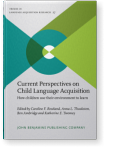From grammatical categories to processes of categorization
The acquisition of morphosyntax from a usage-based perspective
Current version of usage-based grammars propose that grammatical categories are language-specific local generalizations rather than universal building blocks of linguistic structure. This changes the perspective on what learning syntax or morphology is about. Instead of activating innate knowledge that provides the access to possible syntactic structures, children need to build the grammatical representations based on the linguistic input they receive in their communicative interactions. In doing so, they go through processes of re-representation regarding the underlying concepts and the structural generalizations. The process of conceptual integration is illustrated with the domain of space, where there is no direct connection between percepts and linguistically encoded notions. Language learning itself tunes the child’s attention to the distinctions made in the target language. Morphological categories differ in their conceptual unity and morphological regularity and provide different learning problems. Plural marking serves as an example to show how a category with conceptual unity raises learning challenges because of allomorphy (several affixes that encode the same concept). Finally, the acquisition German case marking is discussed to raise the question whether “case” as such is a useful concept in acquisition research, as case markers are polysemous in encoding different kinds of relations, and formally heterogeneous (pronomimal and nominal paradigms differ in their sub-regularities). These learning problems can only be solved with a bottom-up approach, if we assume that children learn language from language use.
Article outline
- Preface
- Deriving language from interaction
- Categories and categorization in usage-based linguistics
- Categorization processes
- Example 1.Categorization in conceptual development: Representational redescription
- Example 2.Learning inflectional categories with variation
- Example 3.Learning case markers for reference and syntactic role marking
- From a structuralist to a constructivist perspective
- Attention tuning to prosodic cues
- Functional relations: Reference and attribution
- Summary and outlook
-
References
